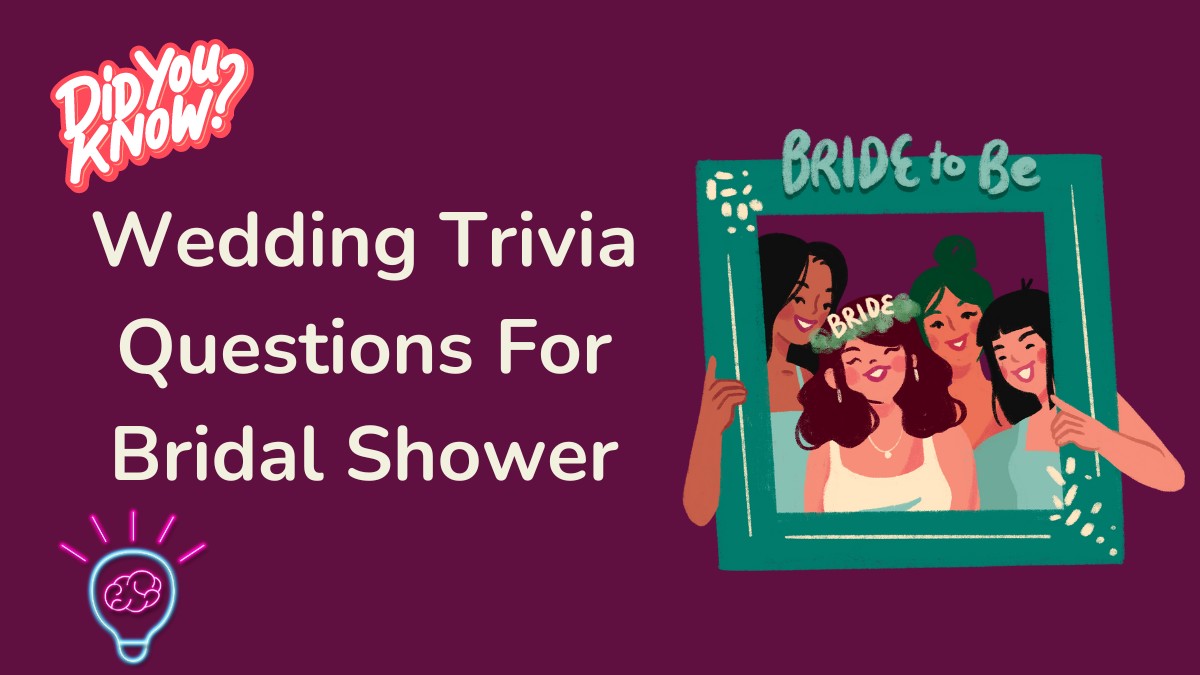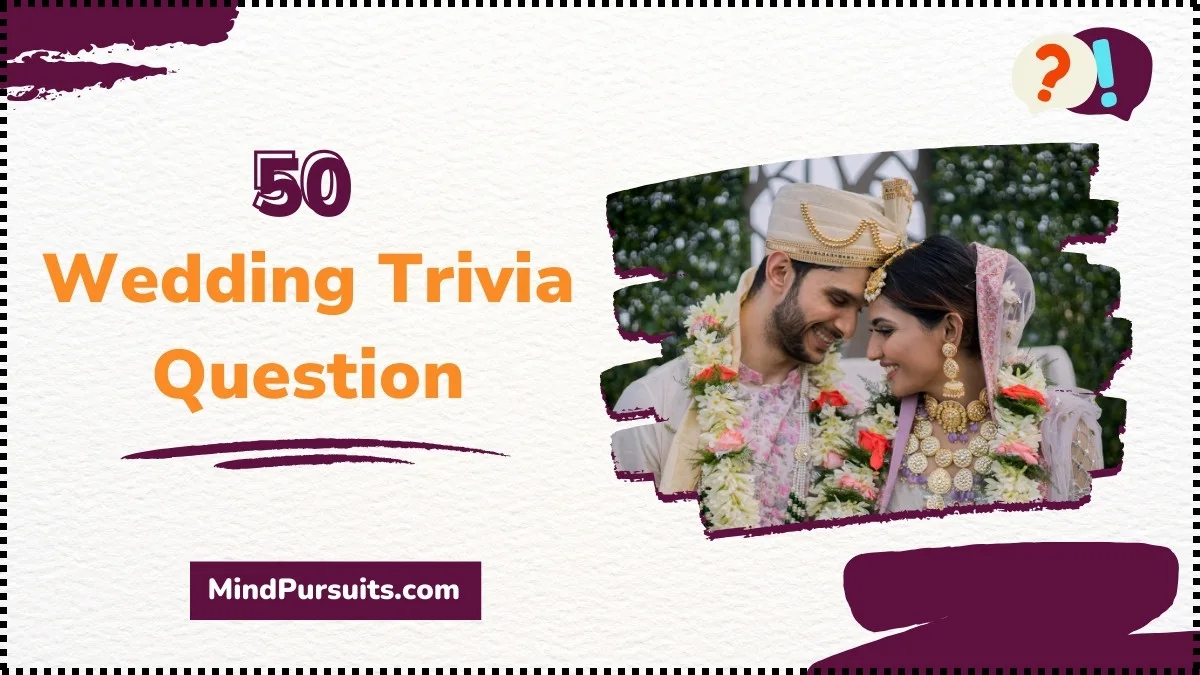Ready to explore the world of wedding trivia?
Get set to embark on a journey through the most amusing and unexpected marriage customs from around the globe.
This is where fun meets facts, blending laughter with learning in a celebration of love’s quirkiest traditions.
Perfect for spicing up any wedding-related conversation, our collection of trivia is your ticket to being the life of the party.
Best Wedding Trivia Question
#1. What is the traditional gemstone used in engagement rings, that symbolizes eternal love?
Diamond.
#2. In which country did the custom of exchanging wedding rings originate?
Ancient Egypt.
#3. What is the significance of the ‘something old, something new, something borrowed, something blue’ tradition at a wedding?
It’s a superstition that these items bring good luck and happiness to the bride.
#4. What flower is most commonly associated with weddings, symbolizing purity and love?
Rose.
#5. Which month is considered the most popular for weddings in the United States?
June.
#6. In what country is it a tradition for the groom to carry his bride over the threshold?
This tradition is found in many cultures, but it is commonly associated with Western cultures (such as in the United States and Europe).
#7. What is the name of the long cloth or veil that extends from a bride’s headpiece or hair, often reaching the floor?
A train.
#8. What is the significance of the ‘wedding cake’ in Western weddings?
The wedding cake symbolizes fertility and prosperity.
#9. In Hindu weddings, what is the significance of the ‘Mangalsutra,’ a necklace worn by the bride?
It symbolizes marital status and the commitment between the couple.
#10. What is a traditional dance performed by the bride and her father called in Western weddings?
The Father-Daughter Dance.
Wedding Trivia Question For The Couple

#11. What is the origin of the term “honeymoon” and what does it symbolize?
The term “honeymoon” is believed to have originated from an old English tradition where newlyweds would drink mead, honey-based alcohol, during the first month of their marriage. The word combines “honey,” representing sweetness, and “moon,” denoting the fleeting amount of time that sweetness would last.
#12. In which culture is it a tradition to carry the bride over the threshold, and what is its significance?
This tradition originates from Ancient Rome. It was believed that carrying the bride over the threshold would protect her from evil spirits lurking at the entrance.
#13. What is the historical reason behind bridesmaids wearing similar dresses in many Western weddings?
In ancient times, bridesmaids wore similar dresses to the bride to confuse evil spirits or potential suitors who might wish to harm the bride or steal her away.
#14. What is the significance of the “something old, something new, something borrowed, something blue” tradition in weddings?
This is a Victorian-era tradition symbolizing continuity (something old), optimism for the future (something new), borrowed happiness (something borrowed), and fidelity and love (something blue).
#15. Which country popularized the tradition of a white wedding dress, and who was the trendsetter?
The tradition of wearing a white wedding dress was popularized in the Western world by Queen Victoria of England when she married Prince Albert in 1840.
#16. In which country is the tradition of writing the names of single women on the bottom of the bride’s shoes practiced, and what does it signify?
In Turkey, it’s a tradition to write the names of single women on the bottom of the bride’s shoes. The names that are worn off by the end of the night are said to be the next to get married.
#17. What is the origin of the “wedding cake” and its traditional significance in weddings?
The wedding cake’s origin traces back to ancient Rome, where a cake of wheat or barley was broken over the bride’s head to bring good fortune and fertility.
#18. In Jewish wedding tradition, what does the breaking of the glass symbolize?
The breaking of the glass in Jewish weddings serves as a reminder of the destruction of the Second Temple in Jerusalem, symbolizing that even in times of joy, one should remember the sorrow and losses of the past.
#19. What is the origin and purpose of the “Trousseau Tea” in Victorian weddings?
Trousseau Tea originated in the Victorian era. It was a tea party where the bride would showcase her trousseau – the clothing and household linen she had collected for her marriage.
#20. In Filipino wedding tradition, what is the significance of releasing a pair of white doves?
Releasing a pair of white doves in Filipino weddings symbolizes a harmonious and peaceful life together for the couple. The doves represent purity, unity, and a life of good fortune.
Wedding Trivia Questions For Bridal Shower

#21. What is the origin of the term “honeymoon”?
The term “honeymoon” comes from the Old English “hony moone,” which is derived from the idea that the first month of marriage is the sweetest
#22. In which country is it a tradition for the bride and groom to smash dishes for good luck?
In Germany, there is a tradition called “Polterabend” where the bride and groom break porcelain dishes the night before their wedding to bring good luck.
#23. What is the significance of the “something old, something new, something borrowed, and something blue” tradition?
This tradition is based on an old English rhyme, where “something old” represents continuity, “something new” offers optimism for the future, “something borrowed” symbolizes borrowed happiness, and “something blue” stands for purity, love, and fidelity.
#24. Which culture popularized the white wedding dress?
The white wedding dress became popular in Western culture after Queen Victoria wore a white lace dress at her wedding in 1840.
#25. What is the traditional role of the ‘Best Man’ in a wedding?
Historically, the Best Man was chosen for his strength and bravery. His role was to help the groom in the kidnapping of his bride from neighboring communities and to protect him during the wedding, especially from rival suitors.
#26. Why do couples traditionally save the top tier of their wedding cake?
Couples traditionally save the top tier of their wedding cake to eat on their first anniversary or at the christening of their first child, symbolizing hope and prosperity for the future.
#27. What is the origin of the wedding ring being worn on the left ring finger?
The tradition comes from the ancient Romans, who believed that the vein in the left ring finger (Vena Amoris) ran directly to the heart, symbolizing love and devotion.
#28. In which country is it a tradition to carry the bride over the threshold of their new home?
This tradition is common in Western cultures. It was believed that carrying the bride over the threshold protected her from evil spirits lurking at the entrance.
#29. What is the traditional dance of the bride and her father called?
This dance is commonly known as the “Father-Daughter Dance,” a heartfelt moment during wedding receptions symbolizing the bride’s transition from her father’s care to her spouse’s.
#30. Which flower is traditionally associated with weddings and why?
The rose is traditionally associated with weddings as it symbolizes love, beauty, and passion, elements often associated with marriage. Roses come in various colors, each with different meanings, making them a versatile choice for wedding floral arrangements.
Sample Trivia Question For Wedding

#31. In which country is it a tradition for the bride and groom to break a glass underfoot during their wedding ceremony?
Israel. This Jewish tradition symbolizes the fragility of human relationships and serves as a reminder that marriage requires care.
#32. What is the term for a fear of weddings or getting married, which is recognized as a phobia?
Gamophobia. It derives from the Greek words “games” meaning marriage and “Phobos” meaning fear.
#33. Which famous landmark in New York City is known for hosting numerous “pop-up” wedding ceremonies, especially on Valentine’s Day?
The Empire State Building. Couples often choose this iconic building for its romantic views and historical significance.
#34. In what unique wedding tradition, predominantly found in Congo, are the bride and groom not allowed to smile throughout the entire ceremony?
Congolese wedding tradition. It’s believed that marriage is a serious step, so smiling might signify that they aren’t serious about marriage.
#35. What is the name of the traditional Hawaiian wedding garment, worn by both the bride and groom, which is often white and made of light, flowing fabric?
Holoku. The bride’s version is a wedding gown while the groom wears a shirt and pants of the same material.
#36. Which country has the tradition of a “money dance,” where guests pin money to the bride’s dress during the reception?
The Philippines. This tradition is also observed in other cultures and is seen as a way to help the newlyweds financially.
#37. In South Korea, what is the groom traditionally expected to do before he can leave with his bride?
Beating the feet of the groom. It’s a light-hearted and symbolic gesture to test the groom’s strength and character.
#38. What is the oldest known recorded exchange of wedding rings in history, traced back to ancient Egypt?
The rings were made of braided hemp or reeds and symbolized eternal love and commitment.
#39. What color wedding dress is traditionally worn by brides in China, symbolizing luck and joy?
Red. In Chinese culture, red is considered very auspicious and is associated with happiness and good fortune.
#40. Which country has a wedding tradition where the bride must plant a tree wearing her wedding dress after the ceremony?
The Netherlands. This tradition symbolizes the growth and strength of the marriage.
Funny Wedding Trivia Questions And Answers

#41. What is the traditional reason for bridesmaids wearing similar dresses?
Historically, bridesmaids wore similar dresses to the bride to confuse evil spirits or anyone who might wish harm to the bride.
#42. In medieval times, why were “honeymoons” so named?
The honeymoon originated from the tradition of the bride and groom drinking mead, honey-based alcohol, for a full moon cycle (a month) after the wedding to encourage fertility and prosperity.
#43. What quirky item was commonly used in Ancient Rome to seal the deal in a marriage ceremony?
A kiss! In Ancient Rome, a kiss was legally binding and used to seal contracts, including marriage.
#44. Which country has a tradition of kidnapping the bride as part of the wedding festivities?
In Romania, it’s a playful tradition for the bride to be “kidnapped” by friends or family, and the groom must then pay a mock ransom.
#45. What unusual wedding tradition is practiced in Scotland, involving the bride and sometimes the groom?
The “Blackening of the Bride” is where friends and family surprise the bride (and sometimes the groom) by covering them with a mixture of substances like soot, flour, and syrup!
#46. Why do some believe carrying the bride over the threshold is good luck?
This tradition stems from the belief that it protects the bride from evil spirits lurking below the threshold.
#47. In what quirky competition do Finnish husbands participate, related to their wives?
The Wife Carrying World Championships, where men race while carrying their wives. The prize? The wife’s weight in beer!
#48. What is the bizarre reason behind “Tying the Knot” to marriage?
This phrase originates from an ancient Babylonian custom where threads from the bride and groom’s clothes were tied together to symbolize their union.
#49. What is unique about a traditional Marquesan wedding in the Polynesian islands?
After the wedding, relatives lay side by side in the couple’s bed as a form of blessing and good luck!
#50. In Korea, what unusual post-wedding ritual is performed on the groom’s feet?
The groom’s feet are beaten with fish or a cane before the first night of marriage as a test of strength and character.
Conclusion
Wedding trivia questions offer a delightful blend of culture, history, and humor, unveiling the diverse and often surprising customs associated with marriages around the world.
These questions not only entertain but also educate, revealing the rich tapestry of beliefs and practices that define matrimonial ceremonies across different societies.
Whether it’s about quirky traditions, historical practices, or amusing rituals, wedding trivia encapsulates the universal joy and uniqueness of weddings, making it a fascinating topic for anyone interested in the varied ways love and commitment are celebrated globally.


